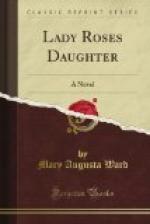Julie leaned her arms on the mantel-piece, and hid her face. She had turned her back to them, and they saw that she was crying softly.
The Duchess crept up to her and wound her arms round her.
“You will, Julie!—you will! Lady Henry has turned you out-of-doors at a moment’s notice. And it was a great deal my fault. You must let us help you!”
Julie did not answer, but, partially disengaging herself, and without looking at him, she held out her hand to the Duke.
He pressed it with a cordiality that amazed him.
“That’s right—that’s right. Now, Evelyn, I leave you to make the arrangements. The keys shall be here this afternoon. Miss Le Breton, of course, stays here till things are settled. As for me, I must really be off to my meeting. One thing, Miss Le Breton—”
“Yes.”
“I think,” he said, gravely, “you ought to reveal yourself to Lord Lackington.”
She shrank.
“You’ll let me take my own time for that?” was her appealing reply.
“Very well—very well. We’ll speak of it again.”
And he hurried away. As he descended his own stairs astonishment at what he had done rushed upon him and overwhelmed him.
“How on earth am I ever to explain the thing to Lady Henry?”
And as he went citywards in his cab, he felt much more guilty than his wife had ever done. What could have made him behave in this extraordinary, this preposterous way? A touch of foolish romance—immoral romance—of which he was already ashamed? Or the one bare fact that this woman had refused Jacob Delafield?
XI
“Here it is,” said the Duchess, as the carriage stopped. “Isn’t it an odd little place?”
And as she and Julie paused on the pavement, Julie looked listlessly at her new home. It was a two-storied brick house, built about 1780. The front door boasted a pair of Ionian columns and a classical canopy or pediment. The windows had still the original small panes; the mansarde roof, with its one dormer, was untouched. The little house had rather deep eaves; three windows above; two, and the front door, below. It wore a prim, old-fashioned air, a good deal softened and battered, however, by age, and it stood at the corner of two streets, both dingily quiet, and destined, no doubt, to be rebuilt before long in the general rejuvenation of Mayfair.
As the Duchess had said, it occupied the site of what had once—about 1740—been the westerly end of a mews belonging to houses in Cureton Street, long since pulled down. The space filled by these houses was now occupied by one great mansion and its gardens. The rest of the mews had been converted into three-story houses of a fair size, looking south, with a back road between them and the gardens of Cureton House. But at the southwesterly corner of what was now Heribert Street, fronting west and quite out of line and keeping with the rest, was this curious little place, built probably at a different date and for some special family reason. The big planes in the Cureton House gardens came close to it and overshadowed it; one side wall of the house, in fact, formed part of the wall of the garden.




